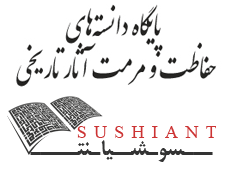رضا شیخالاسلامی
بررسی و امکانسنجی استفاده از سیمانهای بهینهشده با میکروسیلیس در مرمت آثار سنگی مجموعهی جهانی پارسه-پاسارگاد
پایاننامهی کارشناسی ارشد،
دانشگاه هنر اصفهان (دانشکدهی حفاظت و مرمت)، 1387
استاد راهنما: محمدرضا نیلفروشان
استاد مشاور: محمد حسن طالبیان; غلامرضا کیانی
چکیده:
پس از کاوش تخت جمشید اقدامات حفاظتی و مرمتی درمجموعهی تخت جمشید و پاسارگاد انجام شده است. عملکردهایی که در نوع و زمان خود، مناسب بوده و شایستهی قدردانی میباشند و به جرأت میتوان گفت باعث حفظ بقاء و ادامهی حیات بسیاری از آثار باستانی این مجموعه ازجمله آثار سنگی محوطهی تخت جمشید و پاسارگاد گشته است. رایجترین مادهای که از همان سالهای نخستِ شروع برنامههای مرمتی به مدت تقریباً ۷۰ سال در مرمت سنگهای تخت جمشید و پاسارگاد مورد استفاده قرار گرفته، ملات ماسه و سیمان بوده است که درکاربردهای متفاوتی مانند پرکنندگی و چسبانندگی استفاده شده است. دلایلی نظیر پایایی و مقاومت نسبتاً بالا، شکلپذیری و قابلیت استفادهی آسان، نیازنداشتن به نیروی متخصص جهت استفاده، تشابه مواد سازندهی سیمان و سنگ، همچنین اقتصادی و سهلالوصولبودن سبب شده که از این ملات برای کاربردهای گوناگون مرمتی استفاده شود. امروزه، با گذشت زمان شاهد تغییراتی در آثار سنگی و مواد و مصالح مورد استفاده در مرمت مجموعه هستیم. این تغییرات در اثر عواملی چون عوامل فرسایندهی طبیعی، آلایندههای صنعتی و آسیبهای انسانی به وجود آمدهاند که به شکل هوازدگی، شکستگی، ترک، جابجایی، تَورق، پوستهشدن، کمشدن استحکام، ایجاد رسوبات، ایجاد شوره و … مشاهده میشوند. در این پژوهش به بررسی و شناخت ملات ماسه-سیمان بهینهشده با میکروسیلیس بهمنظور استفاده در مرمت آثار سنگی تخت جمشید و پاسارگاد پرداخته شده است. میکروسیلیس محصول فرعی کورهی قوس الکتریکی تولید سیلیس و فروسیلیس بوده و تقریباً مادهی جدیدی در بتنسازی میباشد. چنین بتنی دارای مقاومت زیاد و نفوذپذیری بسیار کم است و با کاهش حرارت هیدراتاسیون، کاهش سیمان در ملات، کنترل واکنش قلیایی سنگدانهها و مصرف آهک موجود، باعث پایداری و استحکام بالای بتن میشود. تکنیکها و روشهای مختلف علمی برای آسیبشناسی ملاتهای رایج و بررسی کیفیت ملات بهینهشده مورد استفاده قرار گرفته است که میتوان به پتروگرافی، میکروسکوپ الکترونی (SEM)، لوپ دیجیتال و دستگاه پراش پرتو ایکس (XRD) اشاره کرد. همچنین ملات ماسه-سیمان بهینهشده با میکروسیلیس، از لحاظ همخوانی رنگی، داشتن مقاومت مناسب و داشتن جرم حجمی مناسب با سنگهای مجموعهی تخت جمشید و پاسارگاد سازگاری دارد و میتواند جایگزین مناسبی برای ملات ماسه-سیمان رایج در مرمت آثار سنگی این مجموعه باشد.
Abstract: After some researches in Takht-e-Jamshid, the restoration and conservation operations started in this collection. These works are proper and honorable for that time and with no doubt, they are the causes of existence of most monuments of this collection and specially the stony monuments of Takht-e-Jamshid and Pasargadae, till today. The most common material which is used for about 70 years in restoration of Takht-e-Jamshid and Pasargadae’s stones is sandy-cement mortar. This mortar is used in different applications such as filling or attaching the fragments. Some reasons such as high level of stability and resistivity, easy forming, no need of expert for using it, besides, similarity of the constructed materials of stone and cement and at the end the financial problems, making this mortar common to be used in different restoration applications. Today by passage of times we can see some changes in restored stony monuments and the materials which are used. These changes are caused by some reasons such as: natural erosion factors, industrial polluters and human damages which are seen in the form of corrosion, fracture, crack, movement, lamination, desquamate, reduction of stability and creation of sedimentation and salt. In this research we are introducing and analyzing the optimized sandy-cement mortar by Microsilice for using in restoration of Takht-e-Jamshid and Pasargadae’s stony monuments. Microsilice is a sub product of electronic arc oven which producing Silica and Fro silica. This material is a new one in making concrete and has a high resistivity and so low penetrability. This material cause high stability and solidity of the concrete by decreasing the temperature of Hydratasion, decreasing the cement of the mortar, controlling the alkaline reaction of screes and usage of available calcite. In addition, the adaptation of colour and having proper resistivity and density similar to the stones of Takht-e-Jamshid and Pasargadae, making the optimized mortar as a good alternative for the common sandy-cement mortar which is used in the restoration of this collection. Different scientific techniques and methods are used in order to pathologize the common mortars and analyzing the quality of the optimized one. For instant we can name Petrography, Electronic microscope (SEM), Digital Loop and X Rate Machine (XRD).
